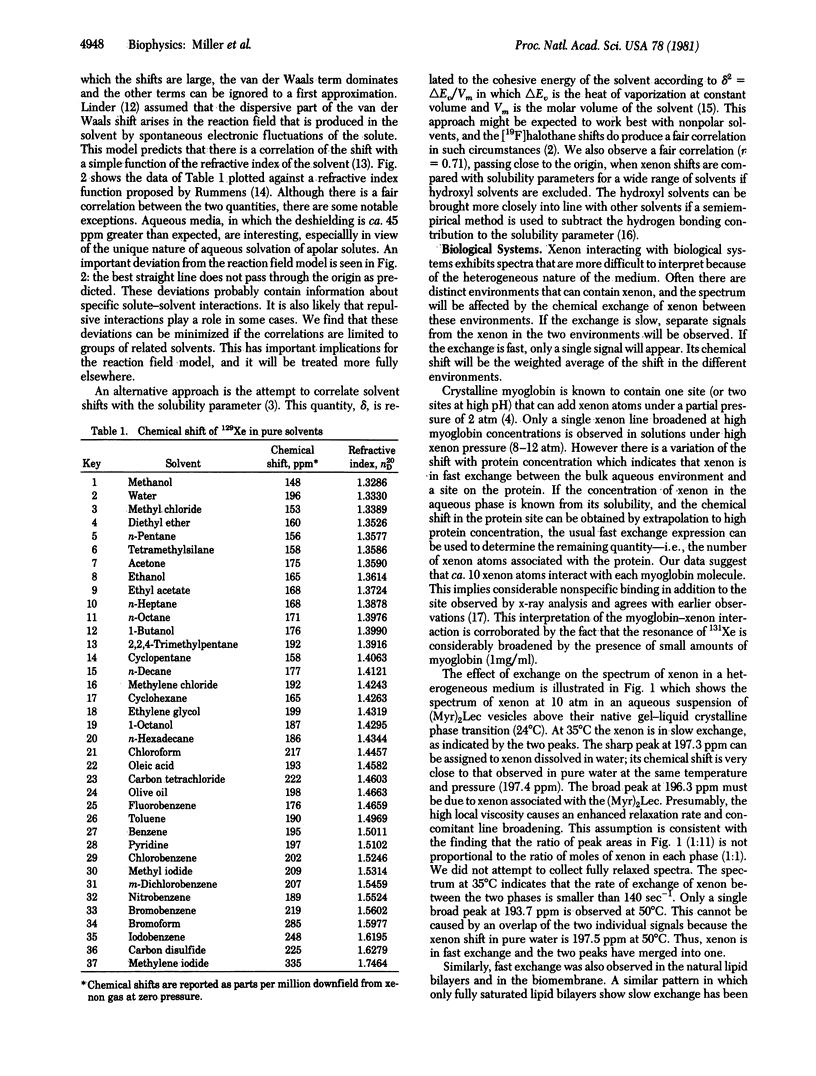Abstract
The rare gas xenon contains two NMR-sensitive isotopes in high natural abundance. The nuclide 129Xe has a spin of 1/2: 131Xe is quadrupolar with a spin of 3/2. The complementary NMR characteristics of these nuclei provide a unique opportunity for probing their environment. The method is widely applicable because xenon interacts with a useful range of condensed phases including pure liquids, protein solutions, and suspensions of lipid and biological membranes. Although xenon is chemically inert, it does interact with living systems; it is an effective general anesthetic. We have found that the range of chemical shifts of 129Xe dissolved in common solvents is ca. 200 ppm, which is 30 times larger than that found for 13C in methane dissolved in various solvents. Resonances were also observed for 131Xe in some systems; they were broader and exhibited much greater relaxation rates than did 129Xe. The use of 129Xe NMR as a probe of biological systems was investigated. Spectra were obtained from solutions of myoglobin, from suspensions of various lipid bilayers, and from suspensions of the membranes of erythrocytes and of the acetylcholine receptor-rich membranes of Torpedo californica. These systems exhibited a smaller range of chemical shifts. In most cases there was evidence of a fast exchange of xenon between the aqueous and organic environments, but the exchange was slow in suspensions of dimyristoyl lecithin vesicles.
Full text
PDF



Selected References
These references are in PubMed. This may not be the complete list of references from this article.
- Chen R. Y., Fan F. C., Kim S., Jan K. M., Usami S., Chien S. Tissue-blood partition coefficient for xenon: temperature and hematocrit dependence. J Appl Physiol Respir Environ Exerc Physiol. 1980 Aug;49(2):178–183. doi: 10.1152/jappl.1980.49.2.178. [DOI] [PubMed] [Google Scholar]
- Cohen J. B., Weber M., Huchet M., Changeux J. P. Purification from Torpedo marmorata electric tissue of membrane fragments particularly rich in cholinergic receptor protein. FEBS Lett. 1972 Oct 1;26(1):43–47. doi: 10.1016/0014-5793(72)80538-6. [DOI] [PubMed] [Google Scholar]
- Franks N. P., Lieb W. R. Where do general anaesthetics act? Nature. 1978 Jul 27;274(5669):339–342. doi: 10.1038/274339a0. [DOI] [PubMed] [Google Scholar]
- Kochler L. S., Fossel E. T., Koehler K. A. Halothane fluorine-19 nuclear magnetic resonance in dipalmitoylphosphatidylcholine liposomes. Biochemistry. 1977 Aug 9;16(16):3700–3707. doi: 10.1021/bi00635a030. [DOI] [PubMed] [Google Scholar]
- Koehler L. S., Cruley W., Koehler K. A. Solvent effects on halothane: 19F nuclear magnetic resonance in solvents and artificial membranes. Mol Pharmacol. 1977 Jan;13(1):113–121. [PubMed] [Google Scholar]
- Pang K. Y., Chang T. L., Miller K. W. On the coupling between anesthetic induced membrane fluidization and cation permeability in lipid vesicles. Mol Pharmacol. 1979 May;15(3):729–738. [PubMed] [Google Scholar]
- Roth S. H. Physical mechanisms of anesthesia. Annu Rev Pharmacol Toxicol. 1979;19:159–178. doi: 10.1146/annurev.pa.19.040179.001111. [DOI] [PubMed] [Google Scholar]
- Schoenborn B. P. Binding of xenon to horse haemoglobin. Nature. 1965 Nov 20;208(5012):760–762. doi: 10.1038/208760a0. [DOI] [PubMed] [Google Scholar]
- Schoenborn B. P. Structure of alkaline metmyoglobin-xenon complex. J Mol Biol. 1969 Oct 28;45(2):297–303. doi: 10.1016/0022-2836(69)90106-5. [DOI] [PubMed] [Google Scholar]
- Trudell J. R., Hubbell W. L. Localization of molecular halothane in phospholipid bilayer model nerve membranes. Anesthesiology. 1976 Mar;44(3):202–205. doi: 10.1097/00000542-197603000-00005. [DOI] [PubMed] [Google Scholar]


